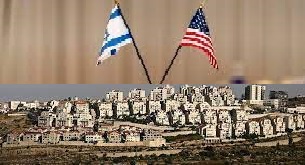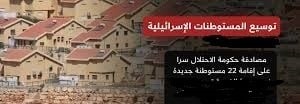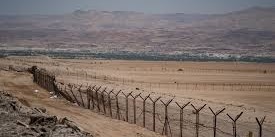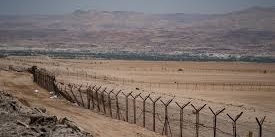By: Madeeha Al-A’raj
The National Bureau for Defending the Land and Resisting Settlements stated in its latest weekly report that , Israeli reporter Barak Ravid, who works for the American ‘Axios, and Hebrew Walla websites’ revealed that a new Israeli settlement plan will be promoted by the end of this month to build more than 4,000 new settlement units in the West Bank. Quoting American and Israeli sources, Ravid confirmed that Netanyahu has informed Biden’s Administration on his intention to promote this settlement project, and that h decided to postpone even discussing the idea of construction in the E1 area, which is sensitive in terms of security and politics.
The announcement of postponing construction in that area came in a broader context and related to the construction plans on the agenda of the Israeli government, including the construction of this large number of housing units in West Bank settlements, indicating that there are efforts by the US administration to try to reduce the number of new units, and that It will be in the settlement blocs and not outside them in the isolated settlements, while an Israeli source said that the Higher Council for Planning and Building in the Civil Administration will convene by the end of this month to approve the project.
According to estimates, President Biden doesn’t like to engage in an open battle with Netanyahu, like the one that occurred during the era of President Barack Obama, when Netanyahu used Congress in his dispute with the administration, and at the same time he does not want the situation to witness an explosion in the West Bank or Gaza with the Israelis while he is about to launching his campaign in the upcoming presidential elections, exhausted by the Russian-Ukrainian war, concerns about the economic situation, and the growing tensions with China.
This means that his options in dealing with the Israeli government, particularly in its relations with the Palestinians and settlement activities, are limited, and his administration can only express concern about the unilateral Israeli measures. Accordingly, it is satisfied with announcing its adherence to the two-state solution and its opposition to Israel’s settlement activities, and at the same time entering into bargains, which are expensive in any case for the Palestinians, such as asking the Israeli government to reduce the number of housing units that Smotrich demands and limiting them to the settlement blocs only, with all that that implies in terms of subcontracting approval to accept the limited expansion of Israeli settlement plans.
This means repeating the scene that accompanied the Israeli government’s decision to back down from the unilateral disengagement in the West Bank in 2005, and the subsequent legalization of 9 settlement outposts last February, by disrupting the role of the UN Security Council, and contenting itself with expressing deep concern.
In parallel with that and without paying attention to the verbal positions of the American administration or international law, the so-called Israeli District Committee decided to expand settlement construction on the lands of the villages of Lifta, Beit Iksa, Beit Hanina al-Tahta and Shuafat in Jerusalem for the benefit of 2 settlements of Ramot and Ramat Shlomo by 1,703 new settlement units in the area .
The separation between Beit Hanina al-Tahta, which became behind the separation wall, and Beit Hanina al-Fawqa within the borders of the occupation municipality, after the wall was pushed back and dozens of cameras were installed along the Jerusalem-Tel Aviv bypass road 443, which divided Beit Hanina into two parts and isolated Beit Hanina al-Tahta from the rest of its lands in Jerusalem. 900 settlement units in the foothills of the lands of Shuafat to the west and linking them to another bypass road as an exit for the settlement on that highway .
According to his usual,demagoguery in lies and forgery, Netanyahu claimed that the West Bank is ‘the land of Israel’ and that settlement there doesn’t violate International Law, because it is a disputed land. He considered that preventing Jews from settling in the West Bank is ‘ethnic cleansing’ and that preventing settlement in Palestinian lands obstacle to Peace” and he claimed that there was never an international decision to prevent Jews from living in Samaria (West Bank).
The extremist Housing Minister Yitzhak Gold Knouf announced the push for a strategic plan that includes most of the settlements of Jerusalem and the West Bank, where he made it clear that he is working with the council ‘Yesha’ calls for the settlement blocs in the West Bank to develop the first unified structural plan for all the settlements together, according to the vision of the right, which considers the West Bank to be the depth and axis of the Jewish narrative and history.
His statements came during a tour he conducted in settlements north of Jerusalem and the West Bank in ‘Sha’ar Binyamin’ and ‘Karnei Shomron’. This plan considers a transgression and an omission of the role of the planning department in the military government ‘Civil Administration’ in Beit El and a practical annexation of the occupied West Bank to the tasks of the Israeli government for the first time since the beginning of its occupation in June 1967.
In a new report disclosed the Israeli discrimination and apartheid, issued by the Kerem Nabot and Haql organizations that are specialized in land research, revealed that half of the lands confiscated in the West Bank by the occupation authorities under the pretext of using them for public purposes are used by settlers only, while 2% of the confiscated lands are used by the Palestinians.
When confiscating lands in the West Bank, the occupation authorities claim that the aim is to build infrastructure, such as streets. However, in the past years, they issued orders to confiscate areas of land in the West Bank, on which 4 settlements were built. The number of land confiscation orders corresponded to the expansion of construction in the settlements. Most of the land confiscation orders were issued in the years 1977-1984, numbering 179 military orders, constituting 56% of the total confiscation orders.
During those years, 70 new settlements were established on these confiscated lands, and this was accompanied by infrastructure, which is mainly streets for these settlements. The report indicated that since the occupation of the West Bank, in 1967, until the year 2022, the occupation authorities issued 313 land confiscation orders covering an area of approximately 74.000 dunums, claiming that they were to serve the needs of the public.
However, the report stated that 37,000 dunums of the confiscated lands contain infrastructure. Mainly streets, used by Palestinians and settlers, and 36,000 dunums are designated for the use of settlers only, and 1,532 dunums are used by Palestinians only. The occupation authorities also issued orders to confiscate ‘archaeological sites’ including the confiscation of 139 dunums of ‘Archilas’ in the Jordan Valley and near the Al-Auja village. These authorities claim that the confiscation of land for the use of settlers is permissible if it also serves the Palestinians, but the facts prove the falsehood of these allegations
List of Israeli Assaults over the Last Week Documented by the National Bureau:
Jerusalem:
- Demanding to uproot the Ghaith Sub-Laban’s family from their home in the Old City of Jerusalem, which they have resided in since 1953, after 45 years of struggle in the courts, facing various types of provocations by the occupation police and settlers, but the solidarity movement by Palestinians and Israeli peace activists thwarted the eviction plan, with continuous pressure by settler groups and organizations on the occupation municipality to demolish and remove the ‘Golden Dome’ that towers over the Al-Rahman Mosque in the Beit Safafa village, and forced the people to shorten the height of the dome and change its color.
Hebron:
- Attacking citizens in the center of Hebron, throwing stones at them under the protection of the occupation forces, and spraying pepper gas at them.
- Allowing settlers to expropriate citizens’ lands and crops in several areas of Masafer Yatta lands.
- Attacking shepherds east of Yatta, assaulting them, chasing their livestock, and preventing them from entering their pastures at gunpoint in the Bwaib area, east of Yatta, and preventing their owners from entering the area.
Ramallah:
- Erecting a number of tents, including a large one, indicating their intention to settle in Jabal Mustafa al-Ali, which belongs to the village of Beitlo, northwest of Ramallah.
- Destroying the monument of the martyr Ziyad Abu Ein for the third time in the town of Turmusaya, destroying olive trees, burning agricultural crops, and destroying building materials and a wall under construction on the outskirts of the town.
Qalqilia:
- Bulldozing lands for citizens east of the village of Siniriya, south of Qalqilya, that are planted with olives in the Al-Wadat area, south of the village, under a settlement law issued about 3 years ago stipulates the establishment of more settlement units in favor of expanding the ‘Etz Efraim settlement’ established on the lands of the village.
Tulkarm:
- Invading Mountain Abu Liqia, which belongs to the village of Beit Lid, and the towns of Anabta, Safarin and Kafr al-Labad, set up 5 tents and a barracks in which they performed Talmudic prayers, in an attempt to control the mountain as a prelude to linking the settlement of ‘Anab’ with the settlement of ‘Avni Hefetz’.
 المكتب الوطني للدفاع عن الارض ومقاومة الاستيطان منظمة التحرير الفلسطينية
المكتب الوطني للدفاع عن الارض ومقاومة الاستيطان منظمة التحرير الفلسطينية




